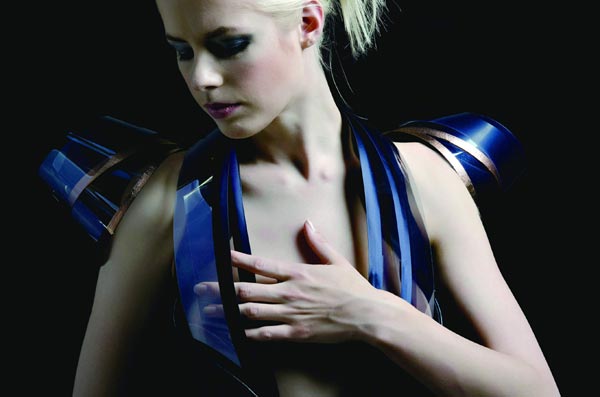
 'Taken 2' grabs movie box office crown
'Taken 2' grabs movie box office crown
 Rihanna's 'Diamonds' tops UK pop chart
Rihanna's 'Diamonds' tops UK pop chart
 Fans get look at vintage Rolling Stones
Fans get look at vintage Rolling Stones
 Celebrities attend Power of Women event
Celebrities attend Power of Women event
 Ang Lee breaks 'every rule' to make unlikely new Life of Pi film
Ang Lee breaks 'every rule' to make unlikely new Life of Pi film
 Rihanna almost thrown out of nightclub
Rihanna almost thrown out of nightclub
 'Dark Knight' wins weekend box office
'Dark Knight' wins weekend box office
 'Total Recall' stars gather in Beverly Hills
'Total Recall' stars gather in Beverly Hills
Instant avatars
Updated: 2012-11-02 17:14
By Zhang Zixuan (China Daily)
|
|||||||||
 |
|
A hi-tech dress made of opaque, smart e-foils, named Intimacy by Dutch designer Daan Roosegaarde. |
The previous version of the design was selected in 2009 by 20th-Century Fox to be the outdoor interaction game to promote the movie Avatar, the designer says, who worked in the US at that time.
Now he's showing the upgraded version, "which is full of possibilities and imagination," says Shi, who now teaches at the Beijing-based Academy of Art and Design, Tsinghua University.
At another corner of the exhibition hall, designer Huang Shi is trying to make the butterfly on the screen fly to the top of the tree by using brain wave. A leaf falls down every time he blinks.
"Through a headband, the screen monitors my degree of relaxation, concentration and blink," says Huang. "When my relaxation reaches 70, the butterfly flies. The higher the score is, the higher the butterfly flies."
Huang believes all interaction between humans and machines will eventually be conducted by brain wave.
"Therefore, the work is my tribute to the future, through which I hope to arouse the audience's interest in technology," he says. Letting people be more relaxed is another reason he designs the technology, he adds.
At the same time, foreign designers also make their statements about art and science in various fun ways.
Dutch designer Daan Roosegaarde brings a hi-tech dress named Intimacy. The dress is made of opaque smart e-foils that can become increasingly transparent based on closeness and personal encounters with people.
The other item he presents is called Lotus, which is made of aluminum foil. When the human hand gets close to the object, the light bulb inside the foils lights up through induction. Then the bulb's light and heat will trigger the foil to unfold like the lotus blossom.
"My works connect technology with emotion, so that the creations will not be that cold," Roosegaarde says.
Another Dutch artist Theo Jansen also bears such human interest in mind. He has been obsessed with walking sculptures for 22 years.
Composed by plastic pipes and driven by wind, the sculptures with multiple feet can walk like real living beings.
Named Strandbeests — meaning sand beasts — these creatures are designed to walk on the beach. They are also able to store air pressure and use it to drive in the absence of wind. They can even change their walking path if the sand is too wet or too dry. And one species of "beast" can anchor itself into the earth if it senses a storm approaching.
"The exhibition is so vivid, which makes abstract science approachable," says Liu Lu, a university student.
"The exhibition aims at revealing the inner relationship between art and science, and tries to explore the possibility of using the scientific methods to express the artistic way of thinking and human interest," says Lu Xiaobo, curator of the exhibition and director of Academy of Art and Design of Tsinghua University.
Contact the writer at zhangzixuan@chinadaily.com.cn.
Most Viewed
Editor's Picks

|

|

|

|

|

|
Today's Top News
Health new priority for quake zone
Xi meets US top military officer
Japan's boats driven out of Diaoyu
China mulls online shopping legislation
Bird flu death toll rises to 22
Putin appoints new ambassador to China
Japanese ships blocked from Diaoyu Islands
Inspired by Guan, more Chinese pick up golf
US Weekly

|

|







